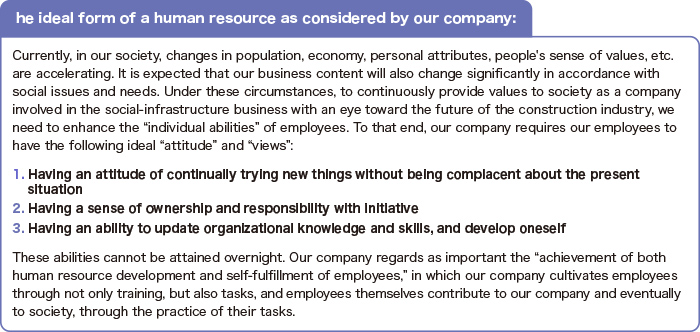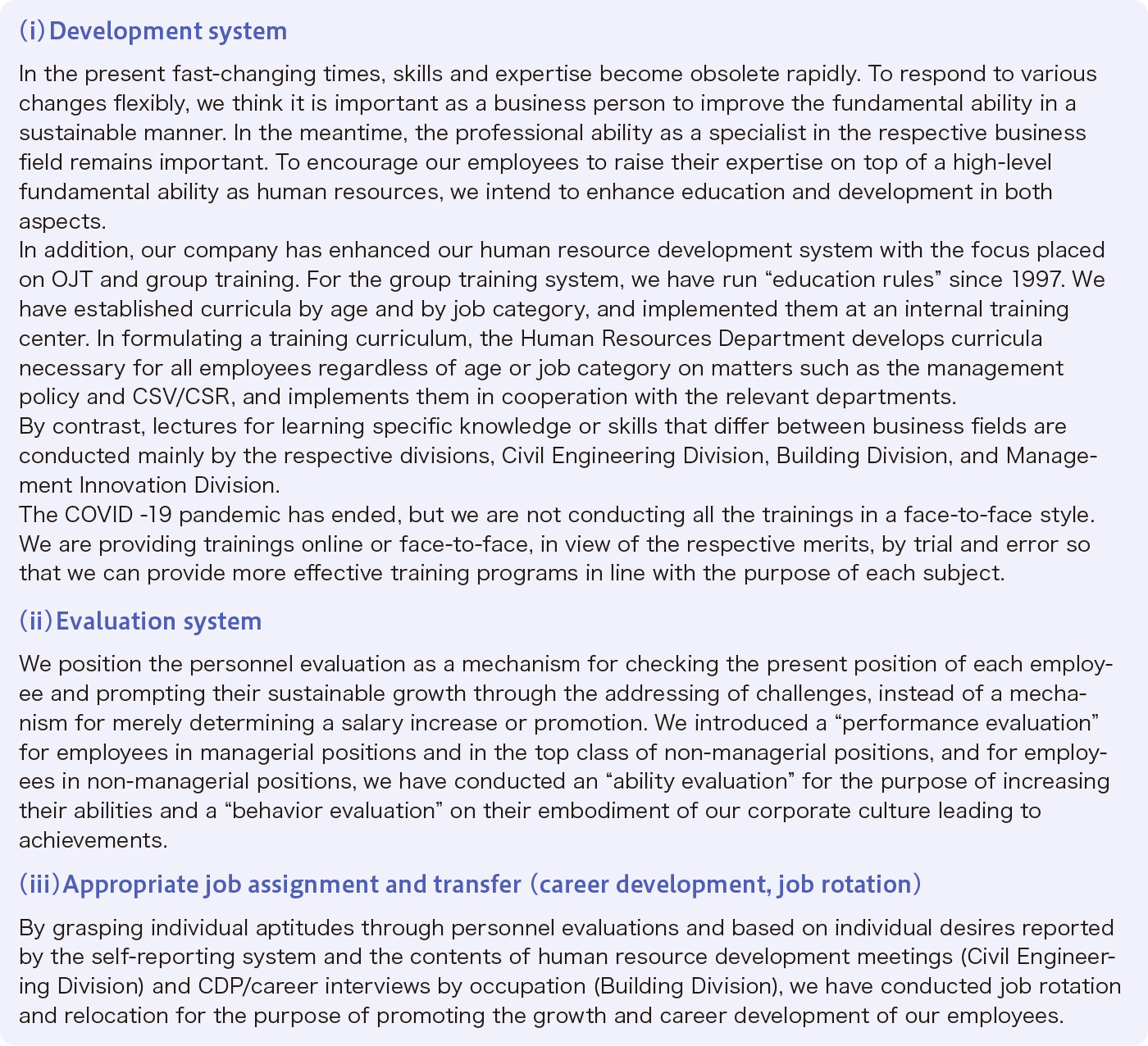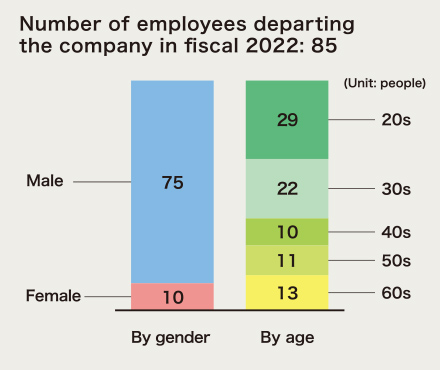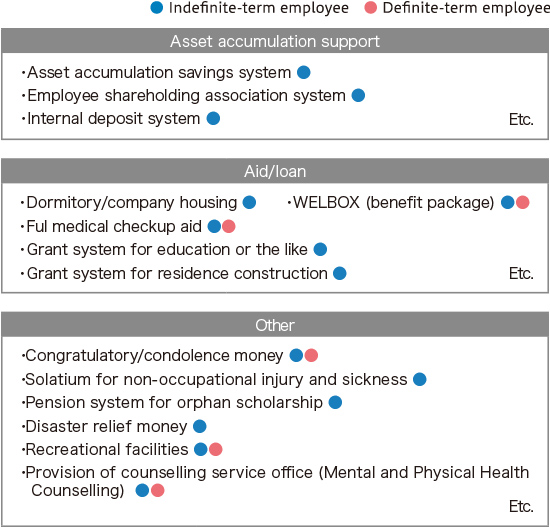Pursuit of diversity-based management
In the modern world, people’s values have diversified in addition to the change of the social structure. In such circumstances, it is essential to build a workplace where each employee can feel at ease when working. Our company considers that the “basics of manufacturing are human development,” and promotes efforts to achieve this. We consider this leads not only to providing flexibility to the company, but also to creating various ideas and strengthening the company.
Policy/view
Seniors’ sentiments that express their adherence to our company’s business include the following.
“Business is a reflection of personality” (a construction work is simply a reflection of personality, and is nothing less than the concretization of an abundant virtue).
“Doing something must not be taken literally as to do something, but means practicing a virtue” (a construction work can be accomplished with the internal and external trust that the person intending to do it has accumulated).
These words represent MAEDA CORPORATION’s attitude toward “human resources,” which is: the “basics of manufacturing are human development.”
We hold the following three views, which were fostered from times past where skills and heritage were handed down from seniors to juniors, or superiors to subordinates, through informal human education at the workplace.
1. Respect personality and respect humanity.
2. A subordinate matures through the bond of trust with his/her superior.
3. Learning on the site is from the “body,” not from the “brain.”
These essences have remained unchanged even in the present day as our basic attitude toward human development.

In addition, our company strives to establish a work environment where each and every employee can demonstrate their personality and ability regardless of gender, age, nationality, etc. in accordance with the “Human Resource Management Policy” and Chapter 3 (Respect for Human Rights) of the “MAEDA Corporate Conduct Charter,” as a first step to realize our diversity.
Management
Our company’s human development is founded on a “corporate culture of developing human resources,” in which the growth of employees would lead to the growth of the company, and a “Human Resource Management Policy,” which stipulates the continued strengthening of the necessary mutual trust between the employees and the company. This is intended to make the four systems: “human resource development system,” “grade system,” “evaluation system,” and “wage system,” complement one another in order to achieve human resource development as a whole. In the development system, in particular, we formulate and implement measures to develop a broad range of human resources from specialists to generalists, while seeking human resources who will form an “integrated infrastructure service company” in cooperation with each division, under the supervision and management of the Human Resources Strategy Department.

Results
Various human resources playing an active part
- Proportion of women in management positions
0.8%*(1.2%* for office work) -
According to the legal requirements for managerial positions, the personnel system was revised in April 2023 and only the management class and the field office director class were defined as managerial positions. As a result, the ratio of female employees in managerial positions has become lower than that in the previous year. In the future, to increase the ratio of female employees in managerial positions, we will focus our efforts on developing human resources who can assume the posts of managers.
* As of April 1, 2023. Excluding authorized executive officers, auditors, and directors. It is calculated based on numerical values in line with the Employment Rules for our company’s employees.
- Proportion of foreign employees0.6%*
-
Although our company’s current proportion of foreign employees is 0.6%, which is very low, both the number of persons and nationalities are increasing gradually. Many of the people who were recruited in Japan are graduates from Japanese universities. In recent years, however, we have also been conducting recruitment activities targeting universities overseas, and the number of new graduate employees and mid-career employees with foreign nationalities has been increasing. In the “de-construction” business such as concessions, there are many opportunities to communicate with overseas companies, and applicants who are interested in such business are increasing and it is expected that the number of employees having various routes will increase. Our company will promote efforts so that each employee can play an active part in the company. In our company, there is no difference due to nationality in the content of each task and treatment.
* For definite-term/indefinite-term workers employed in Japan and locally.
- Foreign
technical interns - While the number of foreign technical interns has been increasing in recent years, our company has currently employed no foreign technical interns, but our cooperative companies have proceeded to employ them. Considering that occupational accidents involving foreign workers, including technical interns, tend to increase in our company, both the civil engineering and the construction operational headquarters are advancing efforts to develop multilingual safety education to reduce such accidents, even though our company has not yet been directly involved in this. Each branch office is working on preventing illegal work and correcting racial wage disparities and conducting instruction in them. We will increasingly focus on paying due regard to human rights.
- Various training systems
- We revise training curriculums, contents of lectures, and others as required. In the education for new employees, we aim to provide equal opportunities for education and encourage them to acquire job knowledge by conducting introductory training, training by job type, and introductory follow-up training in approximately 10 months from their entrance to the company to their formal job assignment. Refer to the website for detailed records of employee training.
Major training systems
The results of employee training programs controlled by the Human Resources Department in FY 2021 are as follows. In the education of new employees, we aim to provide equal opportunities for education and encourage them to acquire job knowledge by conducting introductory training, training by job type, and introductory follow-up training in approximately 10 months from entrance to the company to formal job assignment.
* You can check the whole by scrolling horizontally.
| Name of training |
No. of participants |
Name of training |
No. of participants |
|
|---|---|---|---|---|
| OJT- related |
Target employees for OJT | 475 | Enhanced training by OJT trainer | 129 |
| Group training |
Introductory training for new employees | 105 | Fundamental training in the management system | 129 |
| Follow-up training | 104 | Internal system auditor training | 47 | |
| Training by job category for third-year employees | 116 | Logical mindset training | 83 | |
| Training by job category for fifth-year employees | 119 | Mindset training | 24 | |
| Training for tenth-year employees | 61 | Training in career for 50s | 133 | |
| Training for evaluators | 88 | MAEDA Management Feedback (MMF) post guidance | 109 |
Training hours provided by the company/training hours per person
* You can check the whole by scrolling horizontally.
| FY 2020 | FY 2021 | FY 2022 | |
|---|---|---|---|
| Training hours | 223,653 | 227,581 | 213,935 |
| Number of employees (The average number of all employees during the period) | 3,258 | 3,312 | 3,328 |
| Training hours per person | 68.64732965 | 68.72444512 | 64.28335337 |
Efforts for career development review
Our company has established a “self-declaration system” intended to listen to the opinions of employees. Under this system, a review is conducted twice a year, and requests or proposals from individuals are delivered to the respective departments. This system covers all employees excluding executive officers, branch managers, and senior officials, and approximately 98% of the employees use the system (FY 2021). The acquired information is shared between group leaders or higher officials of the Human Resources Department and the head office and branches. Such information is utilized as data on the direction of career development in the future, satisfaction with the workplace environment, and requests for transfer, and made available for workplace buildings where employees feel at ease when working. To establish an environment where each employee can demonstrate their maximum ability, our company provides careful support for employees’ various work styles and requests, and makes efforts to revitalize the organization and individuals.
In addition to the self-declaration system above, our company has implemented an Engagement Survey system, designed to grasp the status of the entire organization, and a MAEDA Management Feedback (360-degree observation) system, designed for the self-development of managers.
Total number and ratio of departures
The departure ratio (to the total number of employees of all generations) of our company is 3.9% for 20s, 2.9% for 30s, 1.5% for 40s, and 0.9% for 50s. Since the departure ratio of people in their 20s is slightly higher than the other generations, last fiscal year, we started efforts to enhance follow-ups such as those for the training of young employees including new employees and their daily life. We have substantially extended the period for new employee training to approximately one year, in order to provide an equal and uniform education opportunity to all new employees, and conduct individual follow-ups using education leaders, training instructors, and OJT trainers. In addition, we intend to pursue efforts to reduce the departure rate such as increasing the amount of training for young employees in their 20s and 30s and opportunities for employees to attend training on request, regardless of whether they are in a key position or general position, and enhancing follow-ups including those related to the viewpoint of career development.
In addition, one of the recent reasons why people leave their jobs is to return to their hometown. Due to various situations such as effects of a spouse's career due to an increase in dual-income household, child's education, circumstances of parent's home (caregiving, etc.), people who leave their current jobs and change to a new occupation or type of business requiring no transfer are increasing. We consider that this is an important issue and will study measures for supporting our employees to work for the long term.

Ease-to-work support systems
Our company promotes diversity with the aim of “building a workplace where everyone can feel at ease when working with job satisfaction” in which the diversity of individuals is valued and each individual can demonstrate their maximum ability.
To enable our employees to balance childbirth, child-raising, care, and disease treatment, we have built an assistance system that exceeds the statutory level, to establish a support system (see the figure below). With the aim of explaining and disseminating these systems to the families of our employees in an easy-to-understand manner, we have issued a “MAEDA Life Support Guidebook,” and posted a list of the systems on the intranet.
We have also continued to pursue measures to support next-generation development, and acquired “Stage 2” of the certification by the Ministry of Health, Labour, and Welfare (common name: Eruboshi [L-Star]) based on the Act on Promotion of Women’s Participation and Advancement in the Workplace in 2016. Furthermore, we have established and enhanced various systems such as loans for the cost of fertility treatment, and flexible work, teleworking, and flextime systems, to provide support for the balance of work and home.
●Introduction of a non-territorial office
We are promoting the introduction of a non-territorial office nationwide due to the introduction of teleworking. We also intend that members mutually have an interest in other members’ tasks and that information is exchanged naturally because surrounding members always change.
We expect that employees consider the role required of the office in promoting teleworking, and communication between employees, which cannot be covered online, is created.
●Actual state of teleworking at our company
As of April 2023, our employees must come to work, in principle.
The major reasons are to improve communication mainly in business and to provide training especially to young employees at workplaces. Regarding the relationship between teleworking and the realization of growth, we conducted a questionnaire survey on young employees who had worked at our company for one to five years in 2021, and the survey result became controversial. Bearing in mind the reclassification of COVID-19 into Class 5, our company shifted from teleworking to coming to work in December 2022, but the experience of teleworking gave each employee an opportunity to think about the growth and communications through operations and furthermore about productivity.
In the case where an employee can improve his/her productivity by teleworking because he/she has to receive treatment for a disease, has any disability, has to care for family, or the like, the employee is allowed to telework after consulting with his/her superior.
State of acquisition of leave of absence from work and leave for child raising
Male employees who have obtained a leave of absence from work or leave for child raising at our company are increasing in number in comparison to the past, but at a slow pace. In April 2022, our company revised the work rules for employees and introduced a paid “childcare leave” system. For a paid “childcare leave,” it is essential to obtain 20 days’ leave by the time the child becomes one year old.
As a result, the acquisition ratio of childcare leave including childcare-related leave of male employees significantly increased to 87.5% from 8% in FY2021. On the other hand, the acquisition ratio of childcare leave excluding childcare-related leave decreased from the previous fiscal year.
The shortage of child bearers due to the declining birth rate and aging population and the productive-age population decline is said to be normalized in the future. We consider that active participation by male employees in child raising and care will lead to enhancing the work-life balance of employees in addition to realizing the promotion of active social participation by women. We intend to pursue further efforts to ensure that each employee can implement the building of a workplace where all employees regardless of gender can feel at ease when working in the future.
| Item | Acquisition ratio/Number of employees who acquired leave |
|---|---|
| Acquisition ratio of childcare leave including childcare-related leave (females) | 100% |
| Acquisition ratio of childcare leave including childcare-related leave (males) | 89.6% |
| Number of employees taking leave of absence in relation to childbirth or child raising (female) | 94 persons |
| Number of employees taking leave of absence in relation to childbirth or child raising (male) | 104 persons |
Number of employees taking leave of absence in relation to childbirth or child raising (female): Pregnant woman's outpatient leave, maternity leave, child nursing care leave
Number of employees taking leave of absence in relation to childbirth or child raising (male): Spouse's maternity leave, child nursing care leave
A comment by an employee who obtained a leave
of absence from work for child raising
I took childcare leave because I wanted to become a parent together with my wife. I saw my wife becoming a “mother” during her pregnancy and I was feeling that I had started late. I always came home late because of my work and I thought that if I this went on, I would become just a kind of helper in child rearing. So, when my first child was born, I took childcare leave of about two months from the end of January 2022.
I started the handover process of my tasks two months before I took the childcare leave. I sent almost all emails on business by cc to the person who would take over my tasks to inform of the details of the tasks I had to hand over. With the understanding and help of my superior and co-workers in the group, I think I could proceed with the handover smoothly.
My first childcare with no preparation was tough. When the baby was crying during the night, I continued to sleep next to the baby. So, my wife got angry with me and we had a quarrel. We thought about how we could take care of our child without stress every day and made efforts to be on the same page. This is one of our cherished memories.
During my childcare leave, I did almost all of the housework and was appreciated by my wife because she could work on the recovery of her health. Also, when I went to my parents' house and my father saw me taking care of my baby, he said, “Times have changed,” and also said to me, “You should be thankful to your superior and the company. It's a good company, isn't it?”
The baby was born during the COVID-19 pandemic and I could witness the moment when he was born. I saw that the baby's skin was dark-red, had no moles and that a baby wants milk every three hours after the birth. Everything was my first experience and could see carefully how the baby was growing day by day. Every moment during the leave was a treasure (even now, of course.)
Thanks to my boss, co-workers, and family, I was able to take the time for my family and turn my passion, which had previously been put into my work, to my family. I think that such a special time will work to my advantage later.

Dept. 1, Tokyo Building Works Branch
Kai Matsui
Benefits

![Labor, human rights, personnel affairs: [KPI] Labor (i) Diversity-related](/assets/images/english/csr/hrd/dm/dm_img11.jpg)
